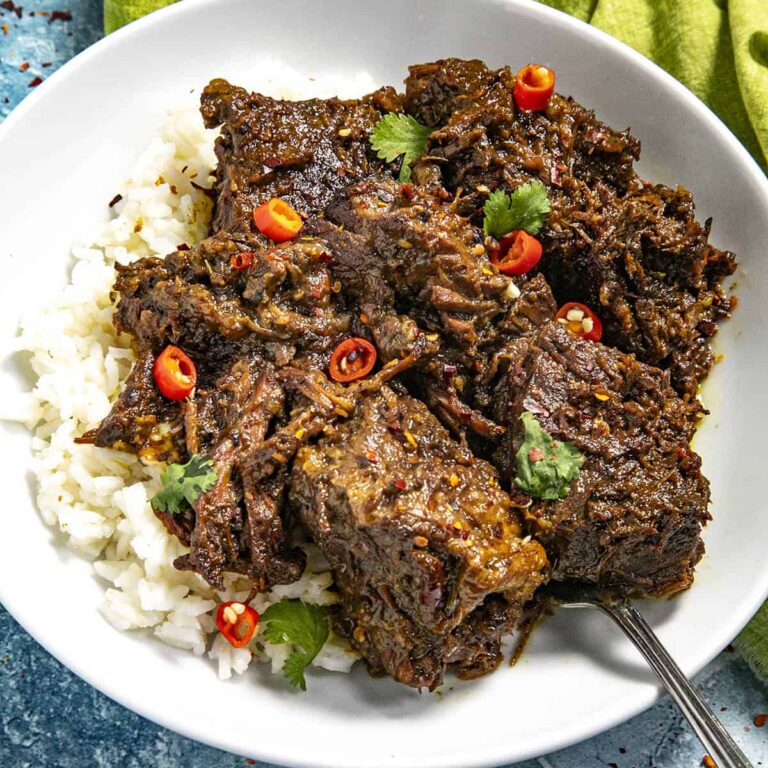Disclaimer: The information provided in this discussion is for general informational and educational purposes only. It is not intended as medical or professional advice. Only a qualified health professional can determine what practices are suitable for your individual needs and abilities.
Indonesian Beef Rendang

Indonesian Beef Rendang (Bodybuilder-Friendly)
Serves 6-8 | Prep: 30 minutes | Cook: 2.5-3 hours | Perfect for meal prep
Nutritional Information (Per Serving)
- Calories: 320
- Protein: 38g
- Carbs: 9g
- Fat: 14g
- Fiber: 3g
Ingredients
For the Spice Paste (Bumbu):
- 8 dried red chilies, soaked in warm water for 15 minutes
- 6 shallots, roughly chopped
- 6 cloves garlic
- 2-inch piece fresh ginger, peeled
- 2-inch piece fresh galangal (or extra ginger)
- 2 stalks lemongrass, tender parts only
- 1 teaspoon ground turmeric
- 1 teaspoon ground coriander
- 1/2 teaspoon ground cumin
For the Rendang:
- 3 lbs (1.4kg) lean beef chuck roast, cut into 2-inch cubes
- 2 cans (14oz each) light coconut milk
- 3 kaffir lime leaves (or 1 tsp lime zest)
- 2 Indonesian bay leaves (or regular bay leaves)
- 1 stalk lemongrass, bruised
- 2 tablespoons tamarind paste
- 2 tablespoons palm sugar or brown sugar
- 2 teaspoons salt (adjust to taste)
- 1 tablespoon coconut oil
For Serving:
- Steamed brown rice (bulking) or cauliflower rice (cutting)
- Fresh cucumber slices
- Boiled eggs (optional protein boost)
- Lime wedges
Instructions
Prepare the Spice Paste:
- Prep Chilies: Remove seeds from soaked chilies for less heat (keep seeds for more spice). Drain and roughly chop.
- Blend Paste: In a food processor or high-powered blender, combine chilies, shallots, garlic, ginger, galangal, lemongrass, turmeric, coriander, and cumin. Add 2-3 tablespoons water if needed to form a smooth paste. This should make about 1 cup of paste.
- Alternative Method: If no food processor, finely mince all ingredients and mash with mortar and pestle, or use pre-made rendang paste from Asian grocery stores.
Cook the Rendang:
Phase 1 – Building Flavor (45 minutes):
- Heat Oil: In a heavy-bottomed Dutch oven or large pot, heat coconut oil over medium heat.
- Cook Paste: Add spice paste and cook for 8-10 minutes, stirring constantly, until fragrant and darkened. The paste should not stick or burn.
- Add Beef: Add beef cubes and stir to coat with paste. Cook for 5-7 minutes until beef is seared on all sides.
- Add Liquids: Pour in coconut milk, add lime leaves, bay leaves, and bruised lemongrass. Bring to a gentle boil.
- Initial Simmer: Reduce heat to low and simmer uncovered for 45 minutes, stirring occasionally.
Phase 2 – Slow Reduction (1.5-2 hours):
- Add Seasonings: Stir in tamarind paste, palm sugar, and salt.
- Long Simmer: Continue simmering on low heat, stirring every 15-20 minutes. The coconut milk will gradually reduce and darken.
- Monitor Consistency: As liquid reduces, stir more frequently to prevent sticking. The beef should become increasingly tender.
Phase 3 – Final Caramelization (30-45 minutes):
- Intensive Stirring: When most liquid has evaporated and mixture is thick, stir constantly to prevent burning.
- Color Development: The rendang is done when the sauce is dark brown, almost black, and coats the beef like a thick glaze.
- Texture Check: Beef should be fork-tender and the sauce should cling to the meat without being dry.
Bodybuilder Modifications
For Cutting Phase:
- Use light coconut milk throughout
- Serve 6oz portion over 2 cups steamed vegetables
- Add extra cucumber and lettuce for volume
- Skip the rice, add boiled egg whites for extra protein
For Bulking Phase:
- Use full-fat coconut milk for last hour of cooking
- Serve 8oz portion over 1.5 cups brown rice
- Add whole boiled eggs and avocado slices
- Include roasted peanuts for healthy fats
Meal Prep Strategy
Sunday Prep:
- Make Full Batch: Cook entire recipe on Sunday
- Portion Control: Divide into 6-8 containers immediately
- Separate Starches: Store rice/vegetables separately to control macros daily
- Freeze Half: Freeze 3-4 portions for weeks 3-4
Daily Serving:
- Microwave: 2-3 minutes, stir halfway through
- Stovetop: Add splash of water if needed, heat gently
- Improves with Time: Flavors develop over 24-48 hours
Pro Tips for Bodybuilders
- Protein Boost: Add 1-2 scoops unflavored collagen powder during final 30 minutes
- Fat Management: Skim excess oil that rises to surface during cooking
- Sodium Control: Use low-sodium tamarind paste and adjust salt to taste
- Spice Level: Start with fewer chilies – you can always add chili flakes when serving
- Texture Preference: For firmer beef (some prefer this), reduce cooking time by 30 minutes
Ingredient Substitutions
- Galangal: Extra ginger + 1 tsp lime zest
- Kaffir Lime Leaves: 1 tsp fresh lime zest
- Tamarind Paste: 2 tbsp lime juice + 1 tbsp brown sugar
- Palm Sugar: Brown sugar or coconut sugar
- Chuck Roast: Beef short ribs or brisket (adjust cooking time)
Storage
- Refrigerator: Up to 5 days in sealed containers
- Freezer: Up to 3 months in freezer-safe containers
- Reheating: Add small amount of water if sauce seems too thick
- Best Quality: Days 2-3 after cooking when flavors have melded
Traditional Serving Notes
Authentic rendang is served at room temperature or slightly warm, never piping hot. The dish should be dry with no visible liquid, and the beef should be so tender it falls apart with a fork. The deep, complex flavor comes from the slow caramelization of coconut milk and spices.
This Indonesian masterpiece transforms tough chuck roast into incredibly tender, flavorful protein. The slow-cooking method makes it perfect for weekly meal prep, while the complex spices provide antioxidants and anti-inflammatory benefits ideal for recovery.
Hey there! We hope you love our fitness programs and the products we recommend. Just so you know, Symku Blog is reader-supported. When you buy through links on our site, we may earn an affiliate commission at no extra cost to you. It helps us keep the lights on. Thanks.
